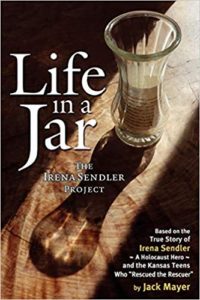Author Jack Mayer has written a gripping true story about courage, hope and determination that shines light on a dark period of history.
When three girls from a rural Kansas high school researched a project for 1999’s National History Day, they started something bigger than anyone would have imagined. Under the guidance of their teacher, Norman Conrad, students Liz Chambers, Megan Stewart, and Sabrina Coons began what would be life-changing for all involved. From a tiny reference in a news magazine, they researched the story of Irena Sendler, a Polish Catholic who organized a network of social workers to save hundreds of Jewish children during World War II. This remarkable feat was suppressed by communist Poland and remained virtually unknown for 60 years.
As the students delved into their Holocaust history project, they fashioned their research into a 15-minute play they called “Life in a Jar.” The play was first seen in Kansas, then the Midwest, then New York, Los Angeles, Montreal and finally Poland where they elevated Irena Sendler to a national hero.
Under German occupation, all Polish Jews in Warsaw were rounded up and forced to live in a ghetto. They could only take what they could carry. Conditions worsened by the day as Jews were deprived of even everyday necessities. The 400,000 Jews sealed behind brick walls lived in unbelievably crowded conditions–sometimes more than 20 people in a two-bedroom apartment. People were starving and dying from untreated sickness, starvation and absolute poverty.
When it became apparent that Jews were systematically being taken away and murdered, Irena Sendler approached the condemned parents to convince them to give up their children so that they could be placed with non-Jewish families, or in Catholic orphanages. Sendler felt it important to keep some sort of record of the rescued children’s names, their new Christian name, and where they were taken. Lists were made and hidden in milk jars, then buried under an old apple tree. In all, 2,500 children were saved. Most were never reunited with their families.
Life in a Jar is an extraordinary story of exceptional people. The students’ individual stories are an integral part of the strength of the project. Irena Sendler’s story of tolerance and respect of all people is inspirational. I highly recommend this story of Kansas teens who “rescued the rescuer.”



